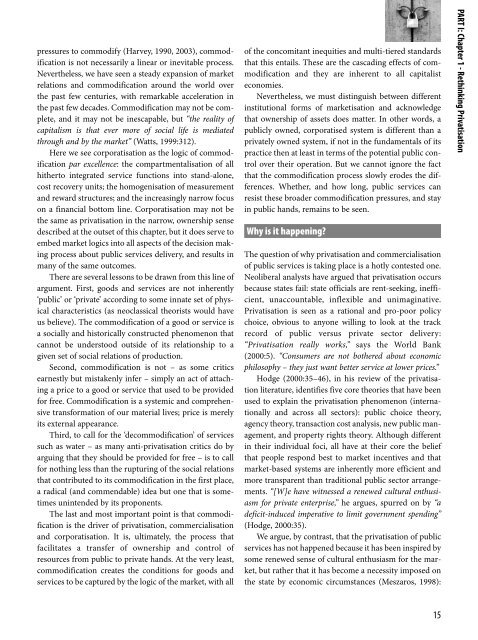Rethinking Privatization Towards a Critical Theoretical Perspective
Rethinking Privatization Towards a Critical Theoretical Perspective
Rethinking Privatization Towards a Critical Theoretical Perspective
Create successful ePaper yourself
Turn your PDF publications into a flip-book with our unique Google optimized e-Paper software.
pressures to commodify (Harvey, 1990, 2003), commodificationis not necessarily a linear or inevitable process.Nevertheless, we have seen a steady expansion of marketrelations and commodification around the world overthe past few centuries, with remarkable acceleration inthe past few decades. Commodification may not be complete,and it may not be inescapable, but “the reality ofcapitalism is that ever more of social life is mediatedthrough and by the market” (Watts, 1999:312).Here we see corporatisation as the logic of commodificationpar excellence: the compartmentalisation of allhitherto integrated service functions into stand-alone,cost recovery units; the homogenisation of measurementand reward structures; and the increasingly narrow focuson a financial bottom line. Corporatisation may not bethe same as privatisation in the narrow, ownership sensedescribed at the outset of this chapter, but it does serve toembed market logics into all aspects of the decision makingprocess about public services delivery, and results inmany of the same outcomes.There are several lessons to be drawn from this line ofargument. First, goods and services are not inherently‘public’ or ‘private’ according to some innate set of physicalcharacteristics (as neoclassical theorists would haveus believe). The commodification of a good or service isa socially and historically constructed phenomenon thatcannot be understood outside of its relationship to agiven set of social relations of production.Second, commodification is not – as some criticsearnestly but mistakenly infer – simply an act of attachinga price to a good or service that used to be providedfor free. Commodification is a systemic and comprehensivetransformation of our material lives; price is merelyits external appearance.Third, to call for the ‘decommodification’ of servicessuch as water – as many anti-privatisation critics do byarguing that they should be provided for free – is to callfor nothing less than the rupturing of the social relationsthat contributed to its commodification in the first place,a radical (and commendable) idea but one that is sometimesunintended by its proponents.The last and most important point is that commodificationis the driver of privatisation, commercialisationand corporatisation. It is, ultimately, the process thatfacilitates a transfer of ownership and control ofresources from public to private hands. At the very least,commodification creates the conditions for goods andservices to be captured by the logic of the market, with allof the concomitant inequities and multi-tiered standardsthat this entails. These are the cascading effects of commodificationand they are inherent to all capitalisteconomies.Nevertheless, we must distinguish between differentinstitutional forms of marketisation and acknowledgethat ownership of assets does matter. In other words, apublicly owned, corporatised system is different than aprivately owned system, if not in the fundamentals of itspractice then at least in terms of the potential public controlover their operation. But we cannot ignore the factthat the commodification process slowly erodes the differences.Whether, and how long, public services canresist these broader commodification pressures, and stayin public hands, remains to be seen.Why is it happening?The question of why privatisation and commercialisationof public services is taking place is a hotly contested one.Neoliberal analysts have argued that privatisation occursbecause states fail: state officials are rent-seeking, inefficient,unaccountable, inflexible and unimaginative.Privatisation is seen as a rational and pro-poor policychoice, obvious to anyone willing to look at the trackrecord of public versus private sector delivery:“Privatisation really works,” says the World Bank(2000:5). “Consumers are not bothered about economicphilosophy – they just want better service at lower prices.”Hodge (2000:35–46), in his review of the privatisationliterature, identifies five core theories that have beenused to explain the privatisation phenomenon (internationallyand across all sectors): public choice theory,agency theory, transaction cost analysis, new public management,and property rights theory. Although differentin their individual foci, all have at their core the beliefthat people respond best to market incentives and thatmarket-based systems are inherently more efficient andmore transparent than traditional public sector arrangements.“[W]e have witnessed a renewed cultural enthusiasmfor private enterprise,” he argues, spurred on by “adeficit-induced imperative to limit government spending”(Hodge, 2000:35).We argue, by contrast, that the privatisation of publicservices has not happened because it has been inspired bysome renewed sense of cultural enthusiasm for the market,but rather that it has become a necessity imposed onthe state by economic circumstances (Meszaros, 1998):PART I: Chapter 1 - <strong>Rethinking</strong> Privatisation15
















